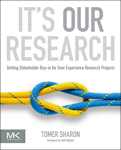 A review of
A review of
It’s OUR Research
by Tomer Sharon
Morgan Kauffman, 2012
The boldfaced Our in the title suggests that It’s Our Research may be yet another defensive plea to respect the beleaguered usability person. That interpretation, however, conflicts with the injunction to “develop empathy toward stakeholders” at the end of Chapter One. As the author further explains on page 60, “It’s not your study; it’s theirs and yours.” Whew! It’s a book about teamwork.
It’s also a textbook. Each chapter begins with a bullet list of the lessons to be learned on the following pages and ends with the takeaway—perfect preparation for a quiz or midterm. Like many of today’s textbooks, Tomer Sharon’s book gets a lavish use of second colors and illustrations. It also benefits from his ready sense of humor. One chapter heading: “If Life Gives You Limes, Make Mojitos!”
Tomer integrates lengthy quotes from colleagues in frequent sidebars. They provide case studies and best practice advice from some of the big guns in user experience work: Rolf Molich, Gerry Gaffney, Bill Albert, Sylvia Zimmerman, and others. The printed text provides only part of the learning process, though. Sprinkled throughout its pages are QR codes to access videos in which Tomer interviews these and other experts. Most chapters also list references for further reading.
The intended audience for this book is a little puzzling; it’s clearly not for beginners. There are no explanations of methodology for design or evaluation; the reader is expected to know those. There is, however, advice on how to choose among several possible methodologies. So maybe it’s UX 101: “Getting Stakeholder Buy-In for User Experience Research Projects,” as the subtitle says. It is, after all, a solution to one of the problems of the beleaguered usability person.
Speaking colleague to colleague, Tomer offers a mini-UXPA conference between two covers. He writes with easy use of the first- and second-person pronouns, and at times, he sounds like one of those fervent motivational speakers in front of an audience of salespeople.
Readers will find the real nitty-gritty begin to unfold in Chapter Four, “What’s Gonna Work? Teamwork!” and in Chapter Five, “The Single Biggest Problem in Communication Is the Illusion that It Has Taken Place.” An example from Chapter Four: “Asking for account managers’ help is something you should do with extra care because some of them might be sensitive to a situation where someone else approaches ‘their’ clients with different requests.” I wish I had read that at least fifteen years ago.
Chapter Five suggests ways to fine-tune the reporting process: the difference between reports and presentations, informal disclosure of key findings, how to organize the writing process, storytelling, and visual communication. The outstanding utility of this chapter alone goes far beyond the UX context and should be required reading for anybody who claims even a shred of “professionalism.” Tomer clearly knows this information on a first-hand basis; it’s the way he’s written this book.
The short and final Chapter Six is a sweet dessert course on recognizing your success: “trust is established…skeptical stakeholders become believers…business is changed…repeated requests are made for UX research training…” Included is the author’s very personal sidebar, “What Happened When I Invited Executives to Use the Product.” In it, he reveals a valuable way to influence management priorities and budgets, an organizational ploy that I only learned inadvertently several years into my own practice.
Even if you skip some of the material in this compendium of experts’ advice, you’ll find nuggets that haven’t been recorded anywhere else. It’s a very useful book.
这是我们的研究,作者:Tomer Sharon
文章全文为英文版
.
이것이 우리의 연구다 – Tomer Sharon
전체 기사는 영어로만 제공됩니다.
 É nossa pesquisa por Tomer Sharon
É nossa pesquisa por Tomer Sharon
O artigo completo está disponível somente em inglês.
It’s Our Research
Tomer Sharon著
原文は英語だけになります
It’s Our Research (Es Nuestra Investigación) de Tomer Sharon
La versión completa de este artículo está sólo disponible en inglés
